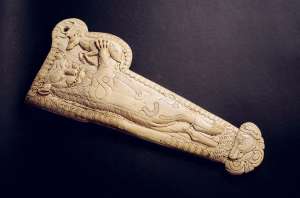
|
SCABBARDS AKINAKA WITH THE IMAGE OF LEO AND DEER
Engraved ivory. 27.7 * 11. Upper end with the lateral blade of two half oval has circular opening for the fastening to the waist belt. Two scenes are engraved on the front surface. Scene in the upper register is filled with the large figure of the lion, that stands on the rear paws, in the front of the holding small deer. On the lower expansion of scabbards (buteroli?) is the image of the rolled up predator and head of goat. By the analogies of Achaemenes time, including relieves from Persepolis, scabbards are dated by the end of 4C - by beginning of 4C BC.
Ly.: Lyry~{yz - Pyy{~ 1980, . 127; 1981, . 87; _S 23.
|
thumbnail size : 300x198 (6,407 bytes)
|
|
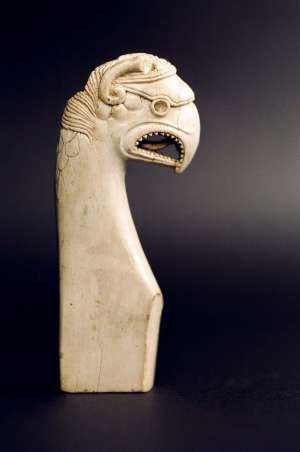
|
HANDLE OF SWORD WITH THE SCULPTURAL IMAGE OF GRIFFIN
Engraved ivory. 11 * 4.9. A relief carved sheep horns, upper part is lion mane, frontal part is stylized and somewhat relief is elevated; the inserted stones, which decorated eyes, were lost; the beak is strongly bent downward; the slightly opened mouth in the grin, small engraving isolated the sharp triangles of the teeth of predator, the tip of the tongue is elevated upward, palate is examined by cut as fir tree; neck, being smoothly enlarged, passes to the bottom of handle. In the profile the neck of griffin, head and breast resemble to Germa. Three spherical protrusions of form something more similar to the temporal rings is under the bent horn. 5C - 4C BC.
Ly.: Lyry~{yz - Pyy{~ 1981 r, . 57 - 58; _S 25.
|
thumbnail size : 300x452 (8,919 bytes)
|
|
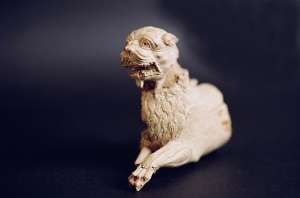
|
LOWER COMPLETION OF RITON(?) IN THE FORM OF SCULPTURAL PROTOMY(?) OF LEO
Engraved ivory. 8.6 * 8.2. Leo is depicted lying with the elongated forward paws (right paw is lost): mouth is widely opened, head is elevated, curly mane by the thinned to the ends falls to the breast, eyes are widely opened and directed upward, ears are stressed. The completions of Riton(?) of protomami(?) of animals were disseminated in Achaemenes Iran, but they were known afterwards - for example, Ritons from Nisa. Schematically transmitted muscle of forearm on the paw finds analogies in the images on relieves in Persepolis and in the treatment of the paw of lion on the scabbards of Akinaka (see 183) of Takhti Sangin. It makes possible to date of Riton in 5C - 4C BC.
Ly.: Lyry~{yz - Pyy{~ 1981, . 57; _S 26.
|
thumbnail size : 300x198 (4,552 bytes)
|
|
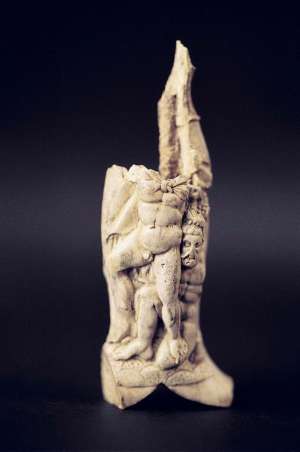
|
HANDLE MAKHAYRY With THE IMAGE OF FIGHT HERCULES With SIREN
Engraved ivory. 10.8 * 3.7. Cylindrical handle is divided into three registers. Upper (in the form of concave cylinder) is decorated with yang twig and vines of Akanf, middle (oval) expanding part is decorated with the two identical relief images of Hercules, which overthrew Siren. Hercules deserve in full body, the right hand, which grippes the knotty club, is raised upward to dealt attack. His left hand, after gripping the long hair of Siren and after falling down downward, is forced it against his thigh. The foot of Hercules holds Siren on the thigh, which stands on one knee. To Hercules the hen of lion, thrown on as raincoat; the paws of lion in neck are tied into knot of Hercules. Siren is naked, well visible the characteristic detail of its appearance - male goat ear. Both figures are sturdy. The dynamics of fight is expressed by the swing of Hercules, by the Siren of attempting to rise and his setting the feet, by their enclosed sturdy bodies in the fight. 4C - 3C BC
Ly.: Lyry~{yz - Pyy{~ 1981q, . 141, pq|. V; _S 27.
|
thumbnail size : 300x452 (9,841 bytes)
|
|
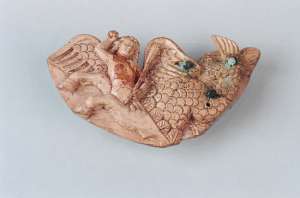
|
Buterol, Hipocamessa
Engraved ivory. 6.7 * 11.8. It is decorated with the relief image of the fantastic essence of woman with the snake-fish-looking tail, with horse feet and wings of bird. In the left hand shi vertically holds oar, is ready to throw the round object: shell, apple or stone with right hand. The dissolved long hair flutter by round strands. Face with the long straight nose and the high forehead, the large eyes with the thoroughly studied eyelids, the round eyebrows and the pupils, designated by points; on the lips - smile. The fantastic articulations of the parts of the figure are skillfully executed. The appearance of the image of this nymph of aqueous element, close Skylla or Gippokampesse(?), is completely regular in the temple of the god of Oxa. The style of work makes it possible to date by first half of 2C BC.
Ly.: Lyry~{yz - Pyy{~ 1981q, . 142, VI; _S 32, . 25.
|
thumbnail size : 300x198 (5,953 bytes)
|
|
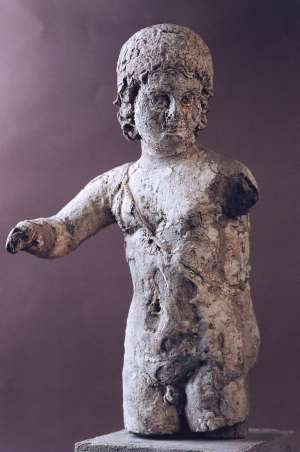
|
APOLLO
Sculpture of clay, covered plaster with the polychromatic painting. 35.0 * 16.0. Large head has the curl hair descending on the shoulder. It is depicted naked, with the cross belt for the carrying quiver of bows (it is preserved only small part in its left hand). 3C - 2C BC
Ly.: _S 64; GRS 4.
|
thumbnail size : 300x452 (15,381 bytes)
|
|
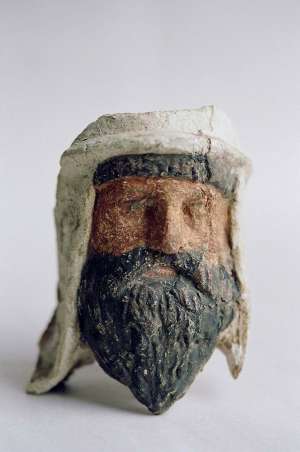
|
HEAD OF BACTORIA RULER
Alabaster, polychromatic coloring. Sculpture. 12.0 * 7.4. Man head is shown into the front (1/3 Naths. It conducted), face is slightly enlarged downward. Narrow long nose - with the western bridge of the nose and little hooked nose in lower half; nostrils are examined as arcs. The deeply put eyes are encircled by the outline of the black ovals, interrupted(?) at the periphery edge and rounded in nose. In the middle of the upper line of oval - rounded spot- pupils. Arcs of eyebrow are shown by the black lines, which detour for the lateral side of nose. Mouth is small. Lower lip is straight line, which adjoins small semi-oval upper lip. Entire lower half of face is framed by the thick black hair, in which the whiskers and beard are put together. Above the low forehead is the protruded and almost smooth strip of the trimmed hair (into the circle). Above the edge of headgear (kirbasiy), his upper part (hemispherical or conical) is repelled. Flat sheets descend from the hoop - Nashchechniki, which close the side m
embers of head and reach the level of chin; below Nashchechniki they are rounded off. Modeling is clear and is confident. Sculpture is painted: beard, whiskers, eyebrow, the oval of face, eye, pupil - into the black color, the person - into the brown, the lips - into the clear red, head-gear of white color.
Ly.: Lyry~{yz - Pyy{~ 1980, . 131, ru. B{|uz{p }uwt
. 128 y 129; Lyry~{yz - Pyy{~ 1981q, . 140, pq|. IV; _S 65; GRS 5.
|
thumbnail size : 300x452 (13,074 bytes)
|
|
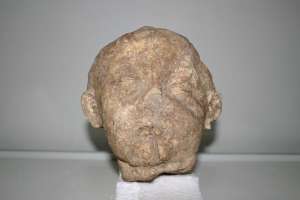
|
HEAD OF BOY
Alabaster with the polychrome painting. Sculpture. 14,5 * 12,0. 1C BC
Ly.: _S 68; GRS 8.
|
thumbnail size : 300x200 (5,219 bytes)
|
|
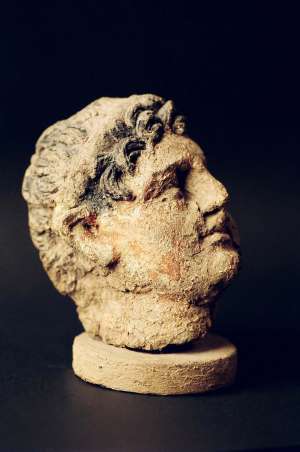
|
HEAD OF HELLENISTIC RULER
Clay of yellow-brown color with the mixed sand and limestone and alabaster with the polychrome painting. Sculpture. 16.0 * 12.0. The head of beardless man in the diadem (it were separately formed from the body). The blue-black hair is tightened by pink tape- diadem, fall on the forehead and the temples. Elegant strands are bent and become narrow to end. Dismembered hair are put together in several parts. The pupils of the deeply put eyes were painted with the paint (plastic and inseparable).
Ly.: Lyry~{yz - Pyy{~ 1980, . 131; Lyry~{yz - Pyy{~ 1981q, . 139, pq|. III; _S 69; GRS 9.
|
thumbnail size : 300x452 (15,038 bytes)
|
|
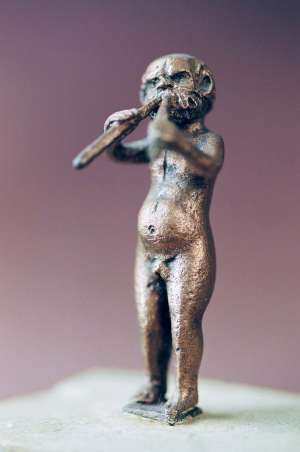
|
VOTIVNYY ALTAR WITH THE SCULPTURE IT IS TRIED
Stone (pedestal), bronze (sculpture). 15.8 * 7.2. Miniature altar with sculpture of marital Marsiya of Siren, which plays on the double-barreled flute. On the frontal side of pedestal is the Ancient Greek inscription: "For the vow dedicated to Atrosok, Oks". According to paleographic data the inscription can be dated 2C AD. The formula of inscription as its content, is standard for Greek dedicatory inscriptions; however, as mentioned in it donor bears the Iranian name of Atrosok, which is transferred as "burning by the sacred fire" or "the useful for the deity of fire". Oks is Greek translation of "Baksh", the ancient name of Amu-Dariya and simultaneously - the name of aqueous deity - the spirit of this river. Inscription on the pedestal makes it possible to consider that temple excavated on the fortification of Takhti Sangin was dedicated to the deity of Baksh-oks (or, at least, this deity was worshipped there together with others). 2C BC
Ly.: Lyry~{yz - Pyy{~ 1980, . 129 - 131; _S 73; GRS 3.
|
thumbnail size : 300x452 (10,234 bytes)
|
|
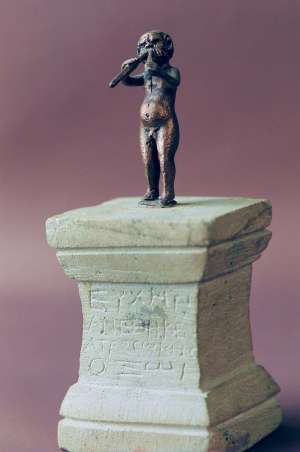
|
VOTIVNYY ALTAR WITH THE SCULPTURE IT IS TRIED
|
thumbnail size : 300x452 (10,867 bytes)
|
|
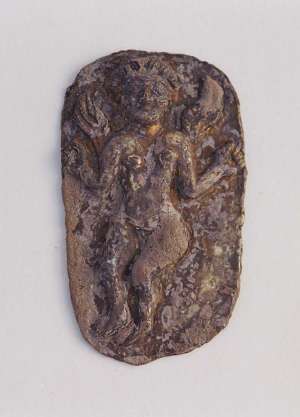
|
WINGED GARPIYA
Relief plate with the gilding. Casting, engraving. 5,5 * 3,3. 2C BC
Ly.: _S 77.
|
thumbnail size : 300x417 (12,755 bytes)
|
|
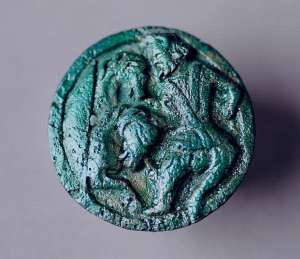
|
SAK, WHO TAKES OUT TWO HORSES
Bronze. Relief. Diameter 4,1. 4C - 3C BC
Ly.: _S 79.
|
thumbnail size : 300x259 (11,959 bytes)
|
|
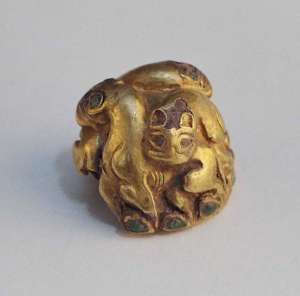
|
PLATE With THE IMAGE OF THE PROCESSION OF PANTHERS
Gold, turquoise. Casting, engraving, incrustation. 2,3 * 2,9. 3C - 2C BC
Ly.: _S 80.
|
thumbnail size : 300x296 (6,813 bytes)
|
|
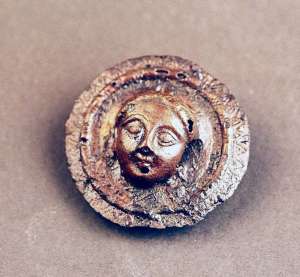
|
SEWED-ON PLATE with THE FEMALE HEAD (Gorgon?)
Silver. Casting, Carved seal. Diameter 5,5. 1C BC
Ly.: _S 81.
|
thumbnail size : 300x277 (12,981 bytes)
|
|
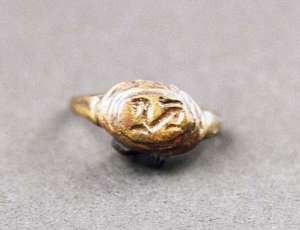
|
RING
Bronze. Diameter 2,0.
Ly.: _S 82.
|
thumbnail size : 300x230 (6,608 bytes)
|
|
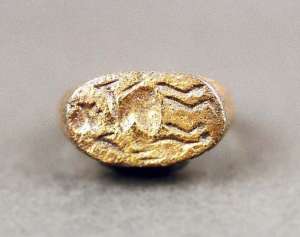
|
RING
|
thumbnail size : 300x237 (7,316 bytes)
|
|
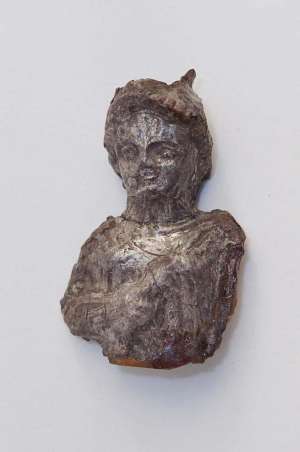
|
GODDESS In KALAFE And GIMATII
Silver. Casting, Carved seal. 7,5 * 4,9. First centuries of AD
Ly.: _S 83.
|
thumbnail size : 300x452 (10,445 bytes)
|
|
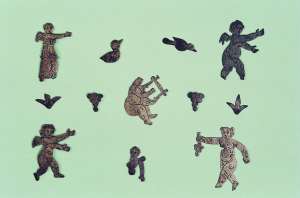
|
1.EROS with THE GRAPE CLUSTER / 2. EROS RUNNING. / 3. EROS RUNNING. / 4. EROS RUNNING. / 5. EROS with THE GRAPE CLUSTER.
1.
Copper, gilding. Carved seal. 6,2 * 4,1. It is depicted in the form of the running baby in three fourths to the left with the large grape cluster in the lengthened forward right hand. Left hand is diverted back and fist is compressed. The swelling of infantile body is transmitted by the engraved folds; by the same lines are shown hair-do, features of face, navel and feature of hem. Face, chest and stomach are depicted in three fourths of them. Foot is in the complex foreshortening. Leftist, covering right, is advanced forward almost in the three fourth turning. Right is shown into the profile with the sole inverted outside. 1C
Ly.: Lyry~{yz - Pyy{~ 1979, . 90, y. 2; _S 85.
2.
Copper, gilding. Carved seal. 6,2 * 4,1. Naked baby in three fourth is turning to the right, who run with the elongated forward hands and the feeble wings behinds. Face of Eros with the living and a gay- naughty look and look sideways to the right. Hair-do with the long undulating curls and the lock-forelock is above the forehead. The proportions of body elongated, however, rounded paunch, thigh and plump legs are loaded. 1C
Ly.: Lyry~{yz - Pyy{~ 1979, . 89 - 90, y. 1; _S 86.
3.
Copper, gilding. Carved seal. 6,1 * 5,5. In posture of figure it is very close to 226. It is depicted running to the right, with two small wings which are developing on behind and concealing each other. But as 225, it holds grape cluster in the elongated hands. 1C
Ly.: Lyry~{yz - Pyy{~ 1979, . 89 - 90, y. 3; _S 87.
4.
Copper, gilding. Carved seal. 5,6 * 4,3. 1C
5.
Copper, gilding. Carved seal. 6,1 x 5,5. 1C
Ly.: _S 89.
|
thumbnail size : 300x198 (5,977 bytes)
|
|
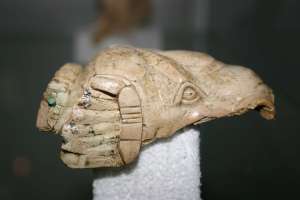
|
HEAD OF ELEPHANT (detail of furniture).
Engraved ivory. 8.2 x 6.0. The top of head of elephant is crowned with the bolster, which is passed through by spherical and two disk-shaped fasteners of pearls. Large frontal portions, ears and trunk are clearly distinguished. Large quantities of fragments of the details of furniture from the ivory are obtained in the temple of Oxa. Some of them are motives of realistic description. 2C - 1C BC
Ly.: Lyry~{yz - Pyy{~ 1981, . 213, y. 19; _S 105.
|
thumbnail size : 300x200 (6,240 bytes)
|
|
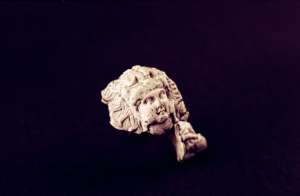
|
IMAGE OF ALEXANDRER OF MACEDONIAN.
Engraved ivory. 3,6 x 2,8. Alexander of Macedonian in the appearance of Hercules is depicted on the front of the mouth of the scabbards of votivnoy(?) miniature makhayry(?). Head is given almost strictly in the front, it is slightly turned to the left and hardly it is noticeably inclined to the left arm. Eyes are planted closely to each other and very deeply (pupils they are not designated), but massive brow come out forward, without overhanging eyes. Look is turned above spectator. The rounded oval of face is tightened by helmet from the skin of the lion: the upper jaw of lion crowns on forehead, lower jaw frames the cheeks of hero in the form of the hoop Nashchechniki of helmet. The fluttering curl-locks of mane are thinly modeled behind the head of Alexander. And on the breast, the paws of lion tied into the knot of Hercules (one paw and the part of the skin were preserved on the left arm, right paw and knot were lost). The face is worn-out condition - surfaces of nose and lips are a little effaced. Also a
bsence of wrinkles on forehead and bridge of the nose and of the narrowed eyes should be noted, characteristic for 3C BC.
Ly.: Lyry~{yz - Pyy{~ 1980, . 131; Pyy{~ 1983; _S 103.
|
thumbnail size : 300x196 (3,735 bytes)
|
|
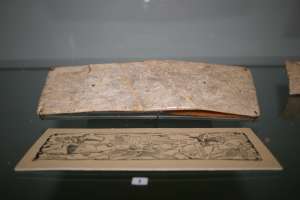
|
PLATE WITH THE SCENE OF "BACTORIAN ON THE HUNTING".
Engraved ivory. 21,3 x 6,2. Two riders (one of them - after being wrapped up back) shoot the bows in behave like a beast. Several mountain rams are killed, the hares and the fox attempt to be hidden from the hunters: the running and killed beasts fill entire field of plate. In the center of plate the wounded lioness by two arrows is depicted; shi attempts to save her two young, being besides and prepares to jump on hunter. As a whole the composition is very dynamic. Before or after of the beginning of 1C.
Ly.: Lyry~{yz - Pyy{~ 1980, . 128 - 129; Lyry~{yz - Pyy{~ 1981q, . 143; _S 107, . 29.
|
thumbnail size : 300x200 (5,817 bytes)
|
|
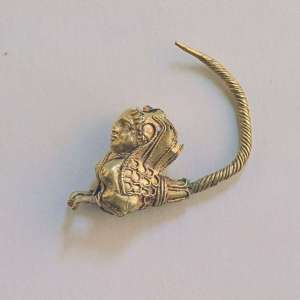
|
LINK In the form PROTOMY OF THE LYING SPHINX.
Electr(Alloy of gold with silver). 3,5 x 2,2. It consists of two parts - interlaced from the thin wire arc, whose tapering point put through into the ear, and strictly the link, fastened to the arc with the aid of the bushing and produced from the thin sheet of elektr. Link depicts the lying sphinx with the female head and the breast; hair-do is visible below the flat cap. The beast paws are dismembered to three finger- claws by cutter, are stretched forward in the elbow joint. Two wings, being vertically risen from the arms, are tightly forced against body and head; feathers are shown with four horizontal rows as soldered on with semicircle from the notched electr wire. Two thin-notched wires are passed along the nape of the neck, they cross as cross belt, and they wind in the ends as spares on the breast. Bushing is decorated with four edgings, also made from the soldered-notched wire. 2C - 1C BC. 1951 Random finding.
QM y~r. 1478. Ly.: Ly~tu 1952; KB 300.
|
thumbnail size : 300x300 (6,120 bytes)
|
|
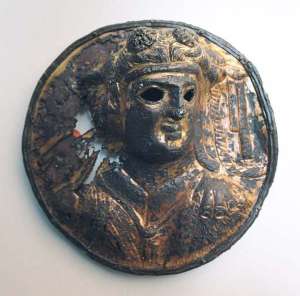
|
FALAR With THE IMAGE OF YOUNG DIONYSIAC.
Bronze, gilding. Carved seal from back, engraving on the gilding. Diameter 14,4 - 14,5. It consists of two round plates - facial and back, fastened between themselves by the bronze rim (width of 4,5 mm) and by eleven rivets. On the face side, the bust of young Dionysiac (arms are expanded into the front, head is a little turned to right) is produced in the high relief (height from 3,4 to 1). The face of oval outlines is delicately modeled. Forehead is low and is wide, brow designated and coming out forward, the cut of the eyes (incrustations were not preserved) are large and elongated, nose is long and narrow, mouth is small chubby, chin and neck are solemn and wide.
Frilled tunic covers both arms and descends with folds to the breast; from under, the edge of lower garment is visible with the section forward. Tape-cross belt covers hair, concealing the lower part of the forehead. Hairs are divided into two equal parts by the straight parting, along sides of them two symmetrical strands bent, which resemble wings or horns. Above the hair, there are two large many-petaled flowers, from which large pointed leaves - stylized image of ivy, descend. Along the sides of the head (to the right they were preserved better), the spirally twisted long curls descend from leaves. As a whole the image on falar goes back to the aspect of young Dionysiac, created Praxiteles, but many details are executed by artisan-torevt of Bactoria and it is rough and schematic, sometimes the original content was lost. On the backside of falar - clamps for the passing the belts are fastened to the plate with the rivets. It is fastened falar with cross lines. 1C BC - 1C AD
1952, random finding.
QM y~r. 1610. Ly.: Suru 1958; Suru 1961; KB 301.
|
thumbnail size : 300x296 (13,082 bytes)
|
|
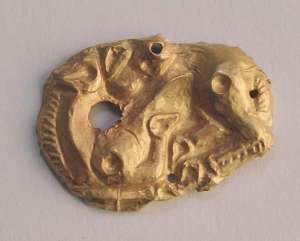
|
SMALL PLATE WITH THE IMAGE OF THE "ROLLED UP" HORSE.
Gold. 2,6 x 3,6. It is produced from the thin sheet with extrusion on the matrix. Horse is depicted as the tucked in feet and the head turned back. In the middle neck and body are passed "edges". Ear and hooves of horse are produced equally as round dent with the outgoing triangular dent from it. On the blade and the thigh there are round dents. Mane and tail are shown by notches. Four circular holes: small hales are between the hooves, under the tail and in the nostril; large hole is under the head with the torn edges.
Msy|~y{ AM-V. 1C - 2C
|
thumbnail size : 300x241 (8,007 bytes)
|
|
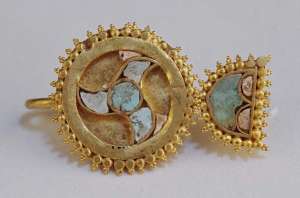
|
FIBULA.
Gold, turquoise, glass paste. 1,9 * 3,0. Coupler - hook from the round@part in the section of wire. Shield is from two parts: large part is round, small part is in the form of segment. They are framed up the edge by pyramids from grain. Inside the shields are figured nests for the inserts from the turquoise and the pink glass paste (gold partitions are soldered on). Msy|~y{ AM-VII. 1C - 2C
Ly.: Rutr 1979, . 584 - 585; _S 157.
|
thumbnail size : 300x198 (7,561 bytes)
|
|
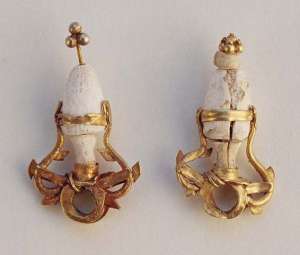
|
LINKS "AMPHORA-LIKE " (pair).
Gold, bronze, pearls, glass paste. 1,5 * 2,5. 1,4 * 2,3. Ring from the thin bronze wire with the coiled mobile coupler. On the arc is "amphora-like" suspension, analogous to 271. The middle part of "Amphora" is the pearl, upper and lower are from the dark glass paste with the external gilding. Knobs of "amphora" completely stylized in the form of the dolphins. The end of the rod of suspension is pearl and pyramid from grain. Lateral suspensions are lost.
Msy|~y{ AM-V. 1C - 2C. Ly.: }. 266; _S 167 - 168.
|
thumbnail size : 300x255 (7,267 bytes)
|
|
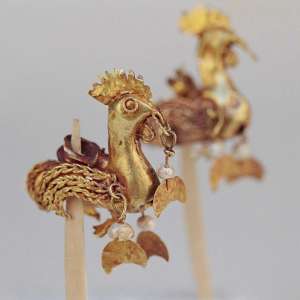
|
LINKS IN THE FORM OF GOLD ROOSTERS (pair).
Gold, silver, pearls. 2,3 * 3,1, 2,3 * 3,5. They consist of three parts: the ring of ear (found only one ring - silver), the gold figurines of roosters and suspension in the form of crescent and pearls. Wings are produced by soldering of three weaving series above the gold leaves, inserted into the slots, made in the hollow corpus of birds. In this way the plates are fixed, the feathers of tail are made in the same technology, as wings. In base of wings and tail there are transverse weavings. Combs are the continuation of the same leaves from which is molded the corpuscle of birds. The feet of birds, cut out also from the flat gold leaves, are connected with the corpuscle by means of the small couplings, in all likelihood, necessary to increase the area for soldering. Ring of ear passes through the upper of two small drum-coils, which are perpendicularly soldered on to another one between wings of birds. For the representation of eyes, bordered edges, and also for ornamentation and finishing of the upper edge
of lower drum is used thin twisted wire. Wire suspensions with the pearl and with the end formed of crescent hanged from the place of fastener of wings (two), also, from the beak of birds (one). Tomb of Ksirov. Fence 5. 1C BC - 2C.
I~r. 42/1 - 2. Ly.: Du~yr 1979, . 577 - 578; Du~yr - Cu~u 1981, . 307 - 314, pq|. V, 1; _S 181 - 182.
|
thumbnail size : 300x300 (8,031 bytes)
|
|
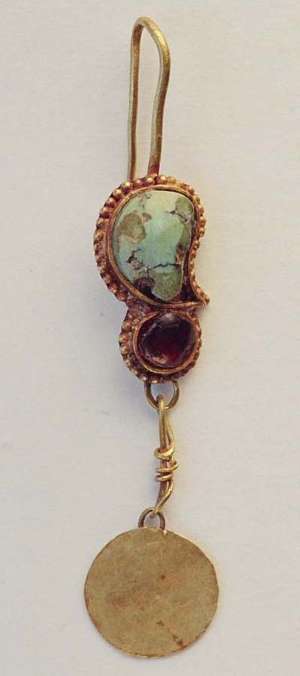
|
LINK.
Gold, turquoise, garnet (?). length of suspension 5,9, the body of plate - 1,8. It is analogous to 285. The preserved length of wire suspension is 2,6 cm, at the its end is disk from thin gold sheet (diameter 1,25). The inserts from the turquoise and garnet (?) were also preserved.
The tomb of Ksirov III, fence 19. 1C BC - 2C AD. I~r. 47/1. Ly.: _S 180.
|
thumbnail size : 300x676 (13,251 bytes)
|
|
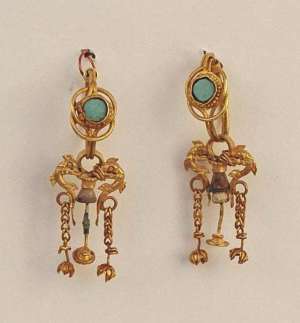
|
LINKS OF AMPHORA-LIKE (pair).
Gold, glass paste. 1,5 x 2,6; 1,3 x 2,3. Couplers are lost, only suspensions in the form of Amphora were preserved. On the shaft from gold, which is finished by pyramid of four grain balls, threaded three beads compose body of Amphora. Above - the massive ring for the suspension, to which two sides of knob in the form of obviously stylized of dolphin, were attached.
1C - 3C Ly.: Upxrp 1977, . 35; _S 217.
|
thumbnail size : 300x323 (9,013 bytes)
|
|
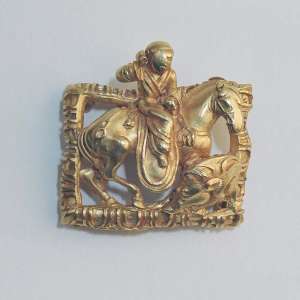
|
BUCKLE WITH THE SCENE OF HUNTING A WILD BOAR.
Gold. Casting. 5,3 x 5,4. The rectangular framework is decorated with OVA(?), divided by two vertical strips. Inside the framework there is solid image of rider who hunts a wild boar. Horse with the mane briefly cut hair that squatted to the rear feet. The harness is visible on the croup, the neck and the snout. Saddle with the low semicircular rear pommel. Long horse-cloth with the rounded edge is overhanging lower than the legs of rider. There are no stirrups. The tapes, decorated with brushes, overhang on both sides from the saddle. Front brush is in the form of the bud of flower. The tail of horse is pressed and omitted between feet. The end of the tail is tied by knot. Rider is shown sitting half-turned. Face was preserved badly (it was effaced right half). Smooth hair-do with the hair is taken away on the back of the head into the tied or pigtail. On the rider the long dressing gown, adjusted to the left side, with the wide sleeves, tightened on the waist by narrow belt; by deep grooves are modeled the
folds of wide sleeves and of bottom edge of clothing; hems descend below elbows. Wide breeches are tightly tightened in the ankle. Instep of right foot is shown schematically, the tiptoe pointed downward. The right hand of rider is raised to the right ear and seemingly compresses the pole of the spear (only small parts were preserved from it). The left hand, bent in the elbow and elongated forward at the level of belt, also held the spear, now lost. In right the lower angle of the framework there is tormented wild boar: the snout turned downward with the powerful canine teeth, forced against the hoof of the forefoot; fur is described short and only by the fine lines. In the massive ear there is a depths for insert. On body of boar there are large depths (drop-like - in the form of commas), which, judging from the insignificant remainders, were filled as OVA(?) on the framework of buckle, with blue glass paste. On the backside of buckle (on the angles of the framework) there are massive loops for the fastening
(one is lost). 1C - 2C Ly.: _S 117.
|
thumbnail size : 300x300 (8,901 bytes)
|
|






























